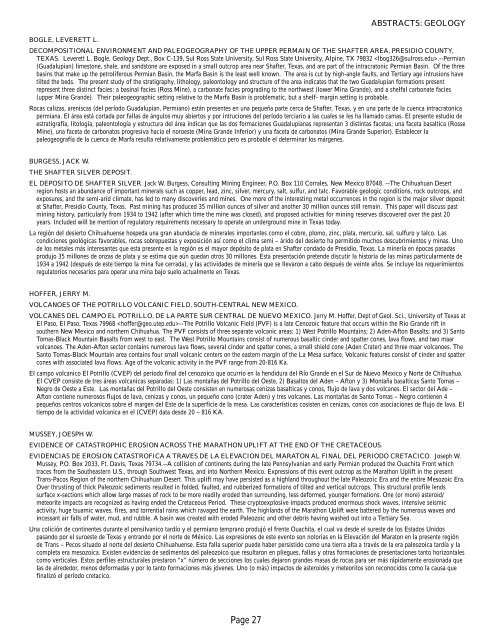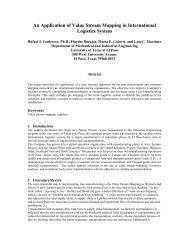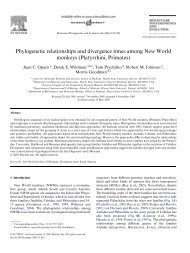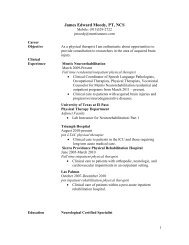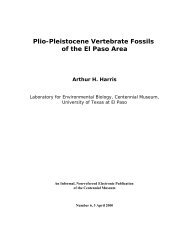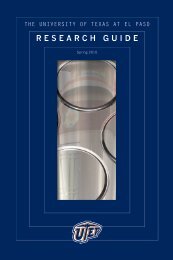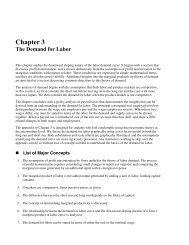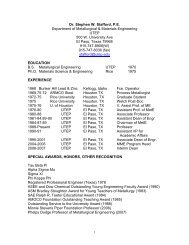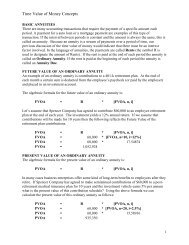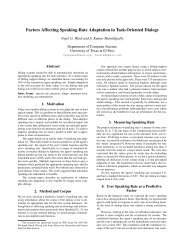Sym - Abstracts - University of Texas at El Paso
Sym - Abstracts - University of Texas at El Paso
Sym - Abstracts - University of Texas at El Paso
You also want an ePaper? Increase the reach of your titles
YUMPU automatically turns print PDFs into web optimized ePapers that Google loves.
ABSTRACTS: GEOLOGY<br />
BOGLE, LEVERETT L.<br />
DECOMPOSITIONAL ENVIRONMENT AND PALEOGEOGRAPHY OF THE UPPER PERMAIN OF THE SHAFTER AREA, PRESIDIO COUNTY,<br />
TEXAS. Leverett L. Bogle, Geology Dept., Box C-139, Sul Ross St<strong>at</strong>e <strong>University</strong>, Sul Ross St<strong>at</strong>e <strong>University</strong>, Alpine, TX 79832 .--Permian<br />
(Guadalupian) limestone, shale, and sandstone are exposed in a small outcrop area near Shafter, <strong>Texas</strong>, and are part <strong>of</strong> the intracr<strong>at</strong>onic Permian Basin. Of the three<br />
basins th<strong>at</strong> make up the petroliferous Permian Basin, the Marfa Basin is the least well known. The area is cut by high-angle faults, and Tertiary age intrusions have<br />
tilted the beds. The present study <strong>of</strong> the str<strong>at</strong>igraphy, lithology, paleontology and structure <strong>of</strong> the area indic<strong>at</strong>es th<strong>at</strong> the two Guadalupian form<strong>at</strong>ions present<br />
represent three distinct facies: a basinal facies (Ross Mine), a carbon<strong>at</strong>e facies prograding to the northwest (lower Mina Grande), and a shelfal carbon<strong>at</strong>e facies<br />
(upper Mina Grande). Their paleogeographic setting rel<strong>at</strong>ive to the Marfa Basin is problem<strong>at</strong>ic, but a shelf- margin setting is probable.<br />
Rocas calizas, areniscas (del período Guadalupian, Permiano) están presentes en una pequeña parte cerca de Shafter, <strong>Texas</strong>, y en una parte de la cuenca intracr<strong>at</strong>onica<br />
permiana. <strong>El</strong> área está cortada por fallas de ángulos muy abiertos y por intruciones del período terciario a las cuales se les ha llamado camas. <strong>El</strong> presente estudio de<br />
estr<strong>at</strong>igrafía, litología, paleontología y estructura del área indican que las dos formaciones Guadalupianas representan 3 distintas facetas; una faceta basaltica (Rosse<br />
Mine), una faceta de carbon<strong>at</strong>os progresiva hacia el noroeste (Mina Grande Inferior) y una faceta de carbon<strong>at</strong>os (Mina Grande Superior). Establecer la<br />
paleogeografía de la cuenca de Marfa resulta rel<strong>at</strong>ivamente problemático pero es probable el determinar los márgenes.<br />
BURGESS, JACK W.<br />
THE SHAFTER SILVER DEPOSIT.<br />
EL DEPOSITO DE SHAFTER SILVER. Jack W. Burgess, Consulting Mining Engineer, P.O. Box 110 Corrales, New Mexico 87048. --The Chihuahuan Desert<br />
region hosts an abundance <strong>of</strong> important minerals such as copper, lead, zinc, silver, mercury, salt, sulfur, and talc. Favorable geologic conditions, rock outcrops, and<br />
exposures, and the semi-arid clim<strong>at</strong>e, has led to many discoveries and mines. One more <strong>of</strong> the interesting metal occurrences in the region is the major silver deposit<br />
<strong>at</strong> Shafter, Presidio County, <strong>Texas</strong>. Past mining has produced 35 million ounces <strong>of</strong> silver and another 30 million ounces still remain. This paper will discuss past<br />
mining history, particularly from 1934 to 1942 (after which time the mine was closed), and proposed activities for mining reserves discovered over the past 20<br />
years. Included will be mention <strong>of</strong> regul<strong>at</strong>ory requirements necessary to oper<strong>at</strong>e an underground mine in <strong>Texas</strong> today.<br />
La región del desierto Chihuahuense hospeda una gran abundacia de minerales importantes como el cobre, plomo, zinc, pl<strong>at</strong>a, mercurio, sal, sulfuro y talco. Las<br />
condiciones geológicas favorables, rocas sobrepuestas y exposición así como el clima semi – árido del desierto ha permitido muchos descubrimientos y minas. Uno<br />
de los metales más interesantes que esta presente en la región es el mayor depósito de pl<strong>at</strong>a en Shafter condado de Presidio, <strong>Texas</strong>. La minería en épocas pasadas<br />
produjo 35 millones de onzas de pl<strong>at</strong>a y se estima que aún quedan otros 30 millones. Esta presentación pretende discutir la historia de las minas particularmente de<br />
1934 a 1942 (después de este tiempo la mina fue cerrada), y las actividades de minería que se llevaron a cabo después de veinte años. Se incluye los requerimientos<br />
regul<strong>at</strong>orios necesarios para operar una mina bajo suelo actualmente en <strong>Texas</strong>.<br />
HOFFER, JERRY M.<br />
VOLCANOES OF THE POTRILLO VOLCANIC FIELD, SOUTH-CENTRAL NEW MEXICO.<br />
VOLCANES DEL CAMPO EL POTRILLO, DE LA PARTE SUR CENTRAL DE NUEVO MEXICO. Jerry M. H<strong>of</strong>fer, Dept <strong>of</strong> Geol. Sci., <strong>University</strong> <strong>of</strong> <strong>Texas</strong> <strong>at</strong><br />
<strong>El</strong> <strong>Paso</strong>, <strong>El</strong> <strong>Paso</strong>, <strong>Texas</strong> 79968 --The Potrillo Volcanic Field (PVF) is a l<strong>at</strong>e Cenozoic fe<strong>at</strong>ure th<strong>at</strong> occurs within the Rio Grande rift in<br />
southern New Mexico and northern Chihuahua. The PVF consists <strong>of</strong> three separ<strong>at</strong>e volcanic areas: 1) West Potrillo Mountains; 2) Aden-Afton Basalts; and 3) Santo<br />
Tomas-Black Mountain Basalts from west to east. The West Potrillo Mountains consist <strong>of</strong> numerous basaltic cinder and sp<strong>at</strong>ter cones, lava flows, and two maar<br />
volcanoes. The Aden-Afton sector contains numerous lava flows, several cinder and sp<strong>at</strong>ter cones, a small shield cone (Aden Cr<strong>at</strong>er) and three maar volcanoes. The<br />
Santo Tomas-Black Mountain area contains four small volcanic centers on the eastern margin <strong>of</strong> the La Mesa surface. Volcanic fe<strong>at</strong>ures consist <strong>of</strong> cinder and sp<strong>at</strong>ter<br />
cones with associ<strong>at</strong>ed lava flows. Age <strong>of</strong> the volcanic activity in the PVF range from 20-816 Ka.<br />
<strong>El</strong> campo volcanico <strong>El</strong> Potrillo (CVEP) del periodo final del cenozoico que ocurrio en la hendidura del Río Grande en el Sur de Nuevo Mexico y Norte de Chihuahua.<br />
<strong>El</strong> CVEP consiste de tres áreas volcanicas separadas: 1) Las montañas del Potrillo del Oeste, 2) Basaltos del Aden – Afton y 3) Montaña basalticas Santo Tomas –<br />
Negro de Oeste a Este. Las montañas del Potrillo del Oeste consisten en numerosas cenizas basalticas y conos, flujo de lava y dos volcanes. <strong>El</strong> sector del Ade –<br />
Afton contiene numerosos flujos de lava, cenizas y conos, un pequeño cono (cr<strong>at</strong>er Aden) y tres volcanes. Las montañas de Santo Tomas – Negro contienen 4<br />
pequeños centros volcanicos sobre el margen del Este de la superficie de la mesa. Las características cosisten en cenizas, conos con asociaciones de flujo de lava. <strong>El</strong><br />
tiempo de la actividad volcanica en el (CVEP) d<strong>at</strong>a desde 20 – 816 KA.<br />
MUSSEY, JOESPH W.<br />
EVIDENCE OF CATASTROPHIC EROSION ACROSS THE MARATHON UPLIFT AT THE END OF THE CRETACEOUS.<br />
EVIDENCIAS DE EROSION CATASTROFICA A TRAVES DE LA ELEVACION DEL MARATON AL FINAL DEL PERIODO CRETACICO. Joseph W.<br />
Mussey, P.O. Box 2033, Ft. Davis, <strong>Texas</strong> 79734.--A collision <strong>of</strong> continents during the l<strong>at</strong>e Pennsylvanian and early Permian produced the Ouachita Front which<br />
traces from the Southeastern U.S., through Southwest <strong>Texas</strong>, and into Northern Mexico. Expressions <strong>of</strong> this event outcrop as the Mar<strong>at</strong>hon Uplift in the present<br />
Trans-Pacos Region <strong>of</strong> the northern Chihuahuan Desert. This uplift may have persisted as a highland throughout the l<strong>at</strong>e Paleozoic Era and the entire Mesozoic Era.<br />
Over thrusting <strong>of</strong> thick Paleozoic sediments resulted in folded, faulted, and rubberized form<strong>at</strong>ions <strong>of</strong> tilted and vertical outcrops. This structural pr<strong>of</strong>ile lends<br />
surface x-sections which allow large masses <strong>of</strong> rock to be more readily eroded than surrounding, less deformed, younger form<strong>at</strong>ions. One (or more) asteroid/<br />
meteorite impacts are recognized as having ended the Cretaceous Period. These cryptoexplosive impacts produced enormous shock waves, intensive seismic<br />
activity, huge tsuamic waves, fires, and torrential rains which ravaged the earth. The highlands <strong>of</strong> the Mar<strong>at</strong>hon Uplift were b<strong>at</strong>tered by the numerous waves and<br />
incessant air falls <strong>of</strong> w<strong>at</strong>er, mud, and rubble. A basin was cre<strong>at</strong>ed with eroded Paleozoic and other debris having washed out into a Tertiary Sea.<br />
Una colición de continentes durante el pensilvanico tardío y el permiano temprano produjó el frente Ouachita, el cual va desde el sureste de los Estados Unidos<br />
pasando por el suroeste de <strong>Texas</strong> y entrando por el norte de México. Las expresiones de este evento son notorias en la <strong>El</strong>evación del Mar<strong>at</strong>on en la presente región<br />
de Trans – Pecos situado al norte del desierto Chihuahuense. Esta falla superior puede haber persistido como una tierra alta a través de la era paleozoica tardía y la<br />
completa era mesozoica. Existen evidencias de sedimentos del paleozoico que resultaron en pliegues, fallas y otras formaciones de presentaciones tanto horizontales<br />
como verticales. Estos perfiles estructurales prestaron “x” número de secciones los cuales dejaron grandes masas de rocas para ser más rápidamente erosionada que<br />
las de alrededor, menos deformadas y por lo tanto formaciones más jóvenes. Uno (o más) impactos de asteroides y meteoritos son reconocidos como la causa que<br />
finalizó el período cretacico.<br />
Page 27


